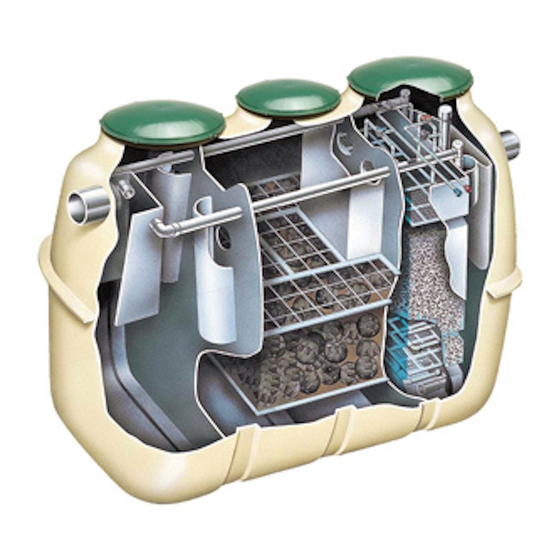Clarus Fusion Series Owner's Manual - Page 16
Browse online or download pdf Owner's Manual for Water Filtration Systems Clarus Fusion Series. Clarus Fusion Series 20 pages. Treatment systems
Also for Clarus Fusion Series: Owner's Manual (20 pages)

1. Odor
Offensive odors are often the result of insufficient or
inappropriate bacterial growth. Causes may include a young
or unestablished system, insufficient air introduction, or the
addition of detrimental chemicals or poisons into the system.
Ensure the blower and air delivery systems are functioning.
Check with the owner regarding chemical use and disinfection
habits. Check all risers and lids to ensure an airtight seal.
2. Foam Formation
Foam forrmation is observed in the following situations:
1. In the early stage of operation when the arerobic bacteria
colony is establishing itseft.
2. When an excess amount of air is supplied for aeration
3. When the difference between ambient temperature and
water temperature is great.
4. When an excessive amount of detergent is introduced.
In most cases, foam will disappear with proper operation.
When excessive amount of detergent have been introduced
to the system remind the owner to use appropriate amount of
detergent.
3. Cloudy Treated Water
• Check the amount of scum and sludge:
If too much scum or sludge is observed, transfer them to the
first chamber and adjust recirculation flow rate as well as
backwash time, frequency and duration. (See backwash flow
adjustment)
• Check the aeration situation:
If uneven bubble generation is observed, adjust valve (1). If
aeration is weak, flush the aeration pipe with air or water.
• Check the recirculation flow rate:
If the recirculation flow rate has increased after the last
inspection, the aeration pipe may be clogged. Flush the
aeration pipe with air or water. If the recirculation flow rate
has decreased after the last inspection, the airlift pump or
recirculation pipe may be clogged. Clean them with a brush
and running water.
• Check the color of the returning sludge from the backwash
pipe:
If the color is abnormally dark, decrease the recirculation flow
rate accordingly. If the TSS of the water from anaerabic to
aeration chamber is high, check the sludge accumulation. If
the sludge accumulation reaches the upper limit, pump out
the sludge. If not, backwashing the anaerabic chamber by
using a manual backwash tool (figure 18) may assist.
TROUBLESHOOTING
4. Blower
Blower motor does not run, with power connected:
• Check the electric supply to the panel, ensuring 120 volt service.
• Check that all breakers and fuses in the panels are intact.
• Check the blowers auto stop mechanism (See pages 17 and 18).
Little or No aeration/ backwash air:
• Check the blower motor is running.
• Check the air line piping connections at the blower.
• Check the air filter and clean or replace if necessary.
• Check the diaphragms and replace if necessary.
• Check the air piping for leaks, clogs, or dislocations and correct
accordingly.
• Verify check valves (if installed) in supply lines are installed
correctly.
Blower- Manual backwash does not work.
• Manually toggle between recirculation and backwash several
times, listening closely for a light click within the unit.
• If the unit clicks, but the air does not switch from aeration to
back-wash, consult the factory.
© Copyright 2020. All rights reserved.
16
